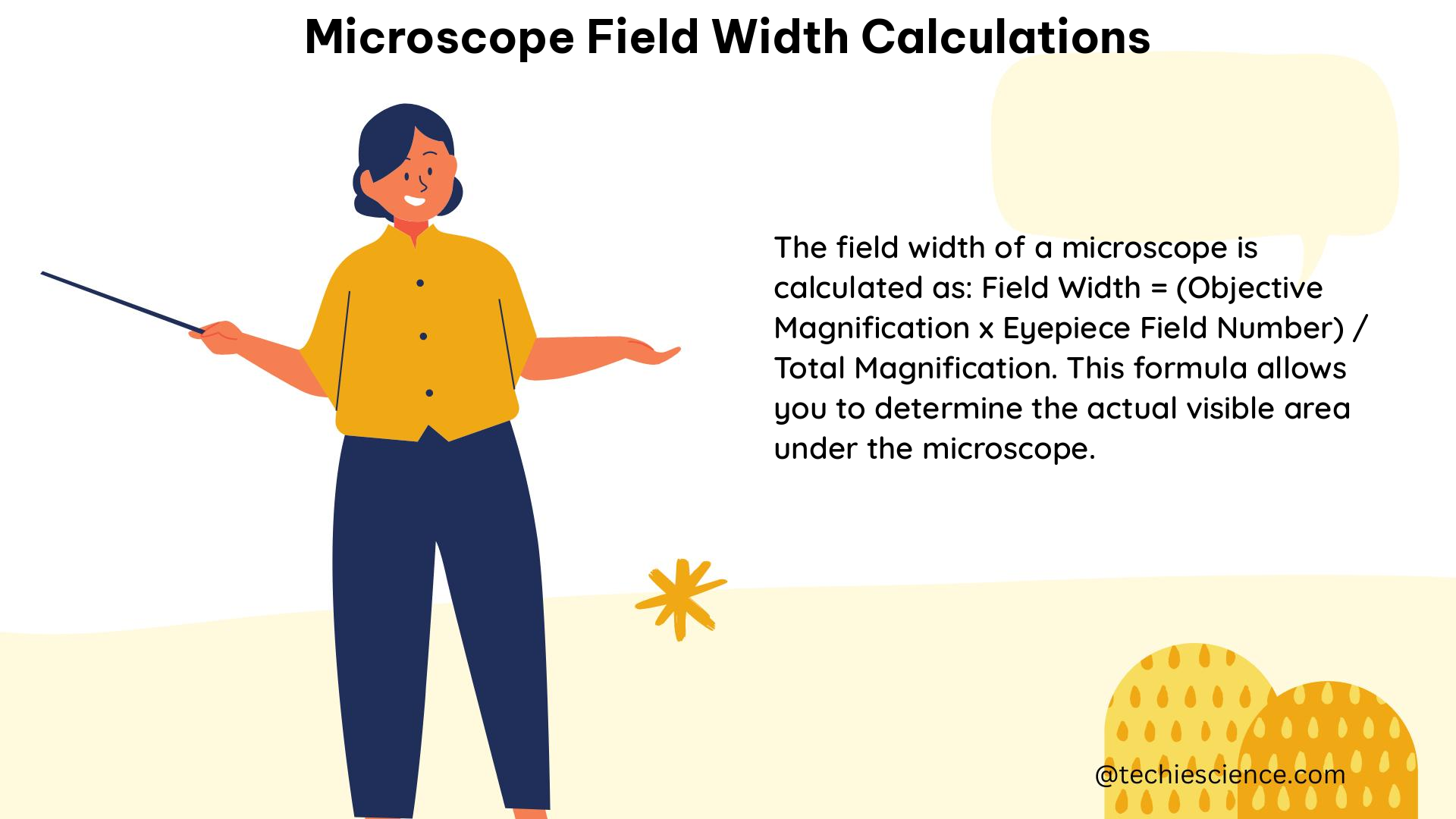Microscope field width calculations are a crucial aspect of microscopy, enabling researchers to accurately determine the dimensions of specimens observed under the microscope. This comprehensive guide delves into the intricacies of these calculations, providing a detailed understanding of the underlying principles, formulas, and practical applications.
Understanding the Fundamentals
The field of view (FOV) of a compound microscope is determined by the field number (FN) and the objective magnification (MO). The field number, typically printed on the side of each lens, represents the diameter of the microscope field. The objective magnification, on the other hand, is the power of the lens to magnify the image.
To calculate the field size (FS), the field number is divided by the objective magnification:
Field size (FS) = Field number (FN) / Objective magnification (MO)
For example, a microscope with an objective lens having a 100X magnification power and a field number of 25 mm would have a field size of 0.25 mm.
The Role of Eyepieces

When an eyepiece is added to the microscope, the field size is determined by the total magnifying power of the entire assembly, which is the product of the microscope eyepiece and microscope objective lens. The field size in this case is calculated as:
Field size (FS) = Field number (FN) / (Objective magnification (MO) × Eyepiece magnification (ME))
For example, if the same microscope with a 100X objective lens and a 25 mm field number is equipped with a 20X eyepiece, the field size would be 0.0125 mm.
Inverse Relationship between Field of View and Magnification
It is important to note that the field of view is inversely proportional to the magnification power of the microscope. As the magnification power increases, the field of view decreases, and vice versa. This relationship is expressed by the following theorem:
Theorem: The field of view of a microscope is inversely proportional to the magnification power of the microscope.
Depth of Field Considerations
In addition to the field of view, the depth of field is another crucial factor in microscopy. The depth of field is the distance over which the specimen appears in focus, and it is affected by the numerical aperture (NA) of the objective lens and the magnification power of the microscope.
The numerical aperture is a measure of the light-gathering ability of the lens and is calculated as the sine of the half-angle of the maximum cone of light that can enter or leave the lens. The depth of field can be calculated using the following formula:
Depth of Field = (NA^2) / (2 * (NA^2 - (NA^2 - sin^2(α/2)) * (M / (M + 1))^2))
where NA is the numerical aperture of the objective lens, α is the half-angle of the maximum cone of light that can enter or leave the lens, and M is the magnification power of the microscope.
Physics Examples
- A microscope having an objective lens with 100X magnification power and a field number of 25 mm would have a field size of 0.25 mm.
- A microscope having an objective lens with 40X magnification power and a field number of 20 mm would have a field size of 0.5 mm.
Physics Numerical Problems
- A microscope has an objective lens with a numerical aperture (NA) of 0.5 and a magnification power (M) of 100x. The half-angle of the maximum cone of light that can enter or leave the lens (α) is 60 degrees. Calculate the depth of field.
Given:
– Numerical aperture (NA) = 0.5
– Magnification power (M) = 100x
– Half-angle of the maximum cone of light (α) = 60 degrees
Substituting the values in the depth of field formula:
Depth of Field = (NA^2) / (2 * (NA^2 – (NA^2 – sin^2(α/2)) * (M / (M + 1))^2))
Depth of Field = (0.5^2) / (2 * (0.5^2 – (0.5^2 – sin^2(60/2)) * (100 / (100 + 1))^2))
Depth of Field = 0.25 / (2 * (0.25 – (0.25 – 0.25) * (100 / 101)^2))
Depth of Field = 0.0125 mm
Figures, Data Points, Values, and Measurements
- Field number (FN): 25 mm
- Objective magnification (MO): 100X
- Field size (FS): 0.25 mm
- Numerical aperture (NA): 0.5
- Magnification power (M): 100x
- Half-angle of the maximum cone of light (α): 60 degrees
- Depth of field: 0.0125 mm
Reference Links
- Linear Measurements (Micrometry) | Nikon’s MicroscopyU
- How To Calculate Field of View for Your Microscope – AmScope
- Measurement with the Light Microscope – Rice University
By understanding the principles, formulas, and practical applications of microscope field width calculations, researchers can make accurate measurements and observations of specimens under the microscope. This comprehensive guide provides a solid foundation for mastering this essential aspect of microscopy.

The lambdageeks.com Core SME Team is a group of experienced subject matter experts from diverse scientific and technical fields including Physics, Chemistry, Technology,Electronics & Electrical Engineering, Automotive, Mechanical Engineering. Our team collaborates to create high-quality, well-researched articles on a wide range of science and technology topics for the lambdageeks.com website.
All Our Senior SME are having more than 7 Years of experience in the respective fields . They are either Working Industry Professionals or assocaited With different Universities. Refer Our Authors Page to get to know About our Core SMEs.